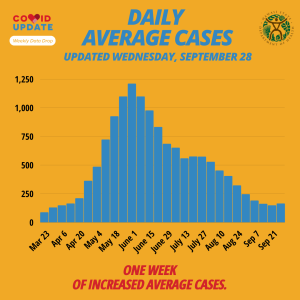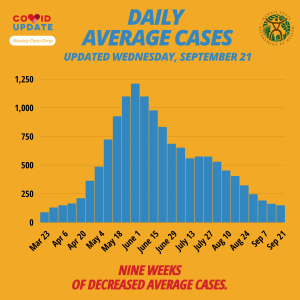Dr. Libby Char: Some advice for managing the road ahead
Posted on Oct 3, 2022 in Capitol Connection, Featured, MainShe’s been described as “no-nonsense,” “a straight shooter,” a doctor who will tell you the truth, even if it hurts. But if ever Hawai‘i needed someone in the right place at the right time, it was Dr. Libby Char, whom Governor Ige appointed in fall 2020 as the state director of health. Her job has been to lead a vast department of some 2,600 employees whose work we often take for granted — in public and behavioral health and environmental protection.

This DOH graph, updated on Sept. 28, includes COVID-19 reinfections, which the health department says now account for about 10% of new confirmed cases in the state.
In a recent Capitol Connection interview, Dr. Char talked about the stresses her team felt handling COVID-19, along with all the other work of the department. “It’s not like the rest of the work went away,” she said. She also said that COVID-19, Red Hill and other recent crises have underscored the importance of a robust public health system — an area that suffered major budget cuts more than a decade ago. “When public health is functioning well, it’s invisible, protecting us every day with clean air, clean drinking water. You talk about an ounce of prevention; prevention is the public health side. It’s really worth the investment.”
Q. Why is getting the bivalent COVID-19 booster important? “The bivalent booster provides better protection from the most common COVID-19 subvariants. If enough people get boosted, we hope to be able to prevent a huge surge in the fall and winter. This booster has two parts to it: the original vaccine, and protection specifically for the Omicron variant, including BA. 4 and BA.5 subvariants. The White House and the CDC say this will allow us to get ahead of things and finally transition to an annual booster, much like annual flu shots.”
Q. Are you concerned that some people with milder COVID symptoms are leading others to think it’s okay to let down their guard? “I’m guessing those with mild symptoms have been vaccinated and boosted. That’s why we keep saying that vaccinations and boosters really work. But we also know people who are getting long COVID, and that’s going to be life-changing for them. They may never return to their jobs or have the quality of life they currently have. And people, especially kūpuna and those with health issues, are still dying from this disease. So we need to remain vigilant and continue to protect ourselves and our loved ones.”

This DOH graph posted Sept. 21 shows daily average COVID-19 cases declining for nine straight weeks.
Q. Is it likely we’ll have to deal with COVID-19 for the rest of our lives? “We all want to be done with COVID, but COVID isn’t done with us. We reported 108 COVID deaths in August and September in Hawai‘i — COVID is still taking a toll on our state. It’s not realistic to think we are going to eradicate COVID. The good news is that staying up to date on vaccines provides strong protection against severe illness and death. The most common types of COVID currently circulating in Hawai‘i are milder, so fewer people who get sick with the virus end up in the hospital. Also, until COVID comes down worldwide, we still have to worry about it here.”
Q. What has been the most rewarding part of this job for you? “The feeling we all did a good job of protecting our state. People have been willing to do the right thing with wearing masks and getting their shots, and there’s a real sense of community. These efforts paid off. Hawai‘i has the second lowest COVID-19 death rate per capita and was ranked as the top state for COVID-19 management by the Commonwealth Fund. That sense of ‘we,’ not ‘I’ is very much the governor’s approach. I always felt he truly approached issues based on what’s good for the people of Hawai‘i, their health and how to protect that — not only in the here and now, but for future generations.”
